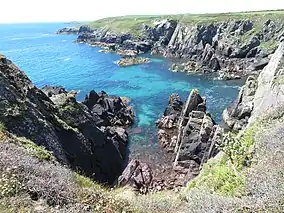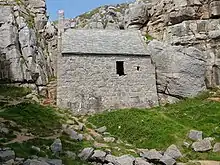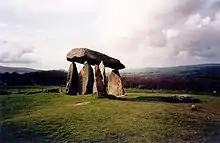Pembrokeshire Coast National Park
Pembrokeshire Coast National Park (Welsh: Parc Cenedlaethol Arfordir Penfro) is a national park along the Pembrokeshire coast in west Wales.
| Pembrokeshire Coast National Park Parc Cenedlaethol Arfordir Penfro (Welsh) | |
|---|---|
IUCN category V (protected landscape/seascape) | |
 Area of Porth Coch Mawr and Porth y Ffynnon, near Porthclais | |
 Location of the national park in Pembrokeshire, Wales | |
| Location | Pembrokeshire, Wales, United Kingdom |
| Area | 629 km2 (243 sq mi) |
| Established | 1952 |
| Website | www |
It was established as a National Park in 1952. It is one of the three National parks of Wales, the others being the Brecon Beacons (Bannau Brycheiniog) and Snowdonia (Eryri). It is the only national park in the United Kingdom to consist largely of coastal landscapes.[1][2]
Landscape
The National Park has a varied landscape of rugged cliffs, sandy beaches, wooded estuaries, wild inland hills, the moorland of the Preseli Hills and the wooded Gwaun valley. The total area is 629 km2 (243 sq mi). There are four distinct sections: clockwise these are the south Pembrokeshire coast, including Caldey Island; the Daugleddau estuary; the St Bride's Bay coast, including the coastal islands; and the Preseli Hills.
The geology of the area is of particular interest with many good exposures both inland and along the coast, exhibiting a variety of rock types and structural features such as natural arches, stacks, rock folding and sea caves. A stack of note is Elegug Stacks (Creigiau Elegug), two large detached pillars of limestone which in the spring provide valued nesting sites for razorbills and guillemots.[3] In the north, the rocks of Carn Llidi, Pen Beri and Garn Fawr, together with the extensive moorland on Mynydd Carningli and Mynydd Preseli, give an exposed and mountainous feel to the landscape, cut through by the wooded valleys of the Gwaun and Nevern. In the west, the National Park is dominated by the broad sweep of St Bride's Bay, bounded at its northern end by Ramsey Island, near St David's peninsula, and at its southern end by Skomer. The southern coast is another contrast, with the limestone plateau and cliffs of the Castlemartin peninsula, the steep-sided wooded valleys inland from Amroth; the Bosherston lakes — now, like much of the coastal strip, in the care of the National Trust — and the tourist resorts of Tenby and Saundersfoot. Between the western and southern areas of the National Park lies the Milford Haven waterway, where the tranquil Daugleddau estuary feeds into one of the finest natural deep water harbours in the world.[4]
The National Park includes many sites (such as Pentre Ifan) of historic and archaeological importance and areas which are of national or international nature conservation significance in their own right, including 7 Special Areas of Conservation, a Marine Nature Reserve, 6 national nature reserves and 75 Sites of Special Scientific Interest.
In 2011, National Geographic Traveler magazine voted Pembrokeshire the second best coastal destination in the world for sustainable tourism.[5][6][7]
In January 2016 the Authority launched the "Changing Coasts" project to document the way the coastline has changed as a result of recent winter storms; the project invites visitors to submit photographs taken (at any time of day) from fixed points; a pilot study will be carried out at Abereiddy.[8]
Pembrokeshire Coast Path
The Pembrokeshire Coast Path is a designated National Trail.[9] It was established in 1970, and is 186 miles (299 km) long, much of it at cliff-top level, with a total of 35,000 feet (11,000 m) of ascent and descent.
The southern end of the path is at Amroth. The northern end was regarded as being at Poppit Sands, near St. Dogmaels, where the official plaque was sited;[10] however, the path now continues to St. Dogmaels,[11][12] where a new marker was unveiled in July 2009,[13] and links with the Ceredigion Coast Path to continue northwards[14] as part of the Wales Coast Path, the 870-mile (1,400 km) long-distance walking route around the whole coast of Wales from Chepstow to Queensferry, which was officially opened in 2012.[15]
Administration
The Park is managed by Pembrokeshire Coast National Park Authority, which has around 150 staff and a committee of 18 members. The Authority's purposes are to conserve and enhance the National Park, and encourage the public to enjoy and understand it. In pursuing these purposes, the authority has a duty to foster the social and economic well-being of the communities within its boundaries. Its offices are in Pembroke Dock.[16] The Chief Executive is Tegryn Jones.[17]
The Authority also manages the entire length of the Pembrokeshire Coast Path, a 186-mile (299 km) national trail which lies almost entirely within the Pembrokeshire Coast National Park.
In light of renaming of the other two Welsh national parks, the authority stated it plans to retains both its English and Welsh name in April 2023.[18]
Beaches
Over the years Pembrokeshire's beaches, all of which lie in the National Park, have been awarded many International Blue Flag Awards (10 in 2014[19]), 47 Green Coast Awards (15 in 2011) and 106 Seaside Awards (31 in 2011).[20][21] In 2011 it also had 39 beaches recommended by the Marine Conservation Society.
Beaches in the park include:
See also
References
- "Welsh Government: Visit Wales". Retrieved 3 July 2020.
- "Pembrokeshire Coast National Park, Wales". National Geographic. 2 November 2017. Retrieved 3 July 2020.
- "Stack Rocks/St Govan's". BBC Wales. Retrieved 5 February 2011.
- "Pembrokeshire Coast National Park". Retrieved 3 July 2020.
- www.NationalTrails.co.uk - news article Archived 2011-06-28 at the Wayback Machine
- "Welsh Wonders: Uncovering Hidden Gems – Europe Guidebook". Retrieved 3 April 2023.
- www.WalesOnline.co.uk - Accolade of being one of world's top trails
- "Pembrokeshire Changing Coasts photography project launched". BBC. 31 January 2016. Retrieved 1 February 2016.
- "Pembrokeshire Coast Path". National Trails. Archived from the original on 17 August 2013. Retrieved 14 August 2013.
- "Coast Path Marker". Pembrokeshire Coastal Photography. Retrieved 29 May 2014.
- John, Brian (2012). Pembrokeshire Coast Path. Aurum Press. ISBN 978-1845137823.
- "Pembrokeshire Coast Path: Newport to St Dogmaels". visitpembrokeshire.com. Archived from the original on 18 June 2013. Retrieved 14 August 2013.
- "St Dogmaels to Newport (Town) 16 miles, (25.7 Kilometres)". Planning a Trip. National Trails. Retrieved 14 August 2013.
- "All-Wales coast path moves a step closer at St Dogmaels". BBC News South West Wales. 21 February 2011. Retrieved 14 August 2013.
- "All-Wales coast path nears completion". BBC News Wales. 17 October 2011. Retrieved 14 August 2013.
- "About the National Park Authority". Pembrokeshire Coast National Park Authority. Retrieved 7 August 2021.
- "Pembrokeshire crackdown on 'wild camping' in car parks". BBC News. 7 August 2020. Retrieved 7 August 2021.
- "Brecon Beacons: Park to use Welsh name Bannau Brycheiniog". BBC News. 17 April 2023. Retrieved 17 April 2023.
- "Blue flags fly over Pembrokeshire beaches". Western Telegraph. 13 June 2014. Retrieved 14 June 2014.
- VisitWales.co.uk - Pembrokeshire beaches Archived 2012-01-06 at the Wayback Machine Retrieved 19 December 2011
- Pembrokeshire (Annual Guide), Pembrokeshire Tourism, 2011


.jpg.webp)

.svg.png.webp)